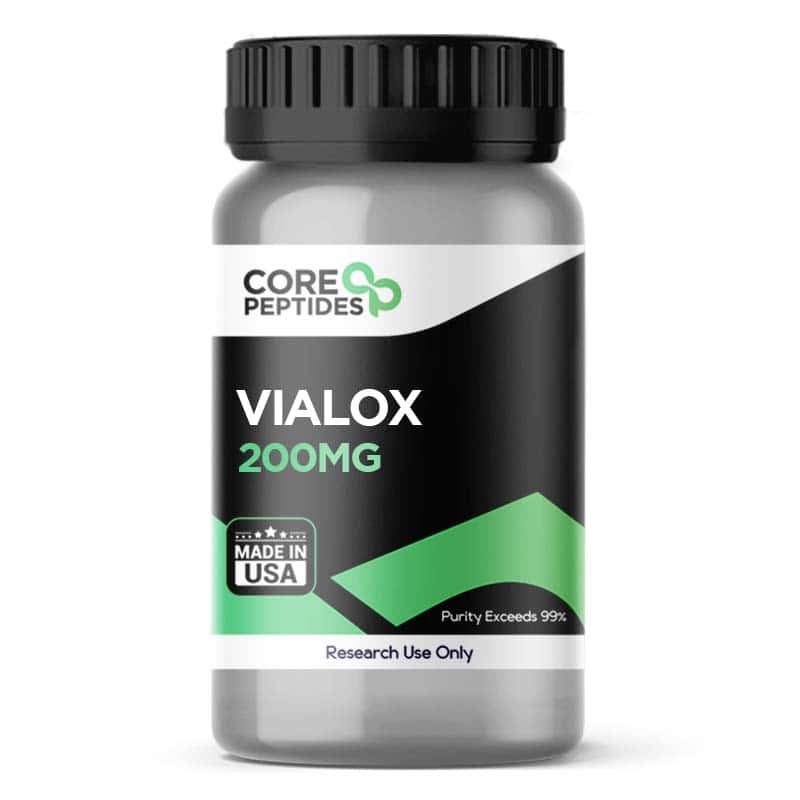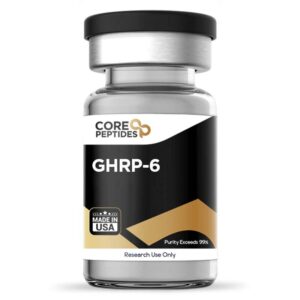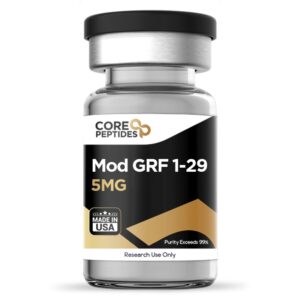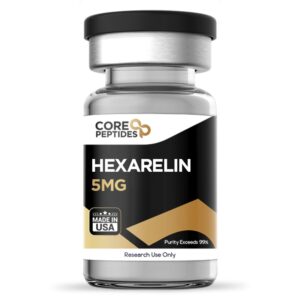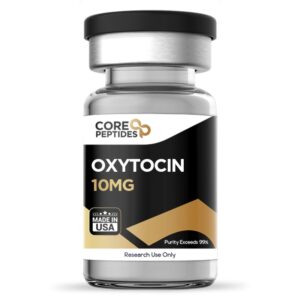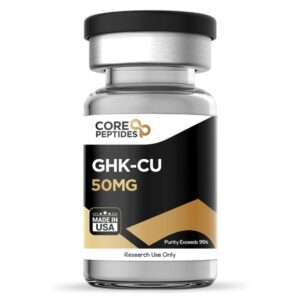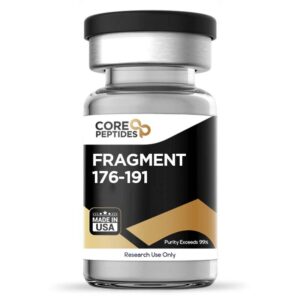Vialox (Pentapeptide-3V) (200mg)
$165.00
Size: 200mg
Contents: Vialox (Pentapeptide-3V)
Form: Lyophilized powder
Purity: >99%
SKU: P-Vialox
FREE Shipping on $200+ orders
Discount per Quantity
| Quantity | Discount | Price |
|---|---|---|
| 5 - 8 | 5% | $156.75 |
| 9 + | 10% | $148.50 |
Vialox Peptide
Vialox, or pentapeptide-3, is a synthetic peptide molecule with the amino acid sequence GPRPA. It is believed to work by blocking neuronal nicotinic acetylcholine receptors located in the postsynaptic membrane of muscle cells. These receptors transmit signals from nerve cells to muscle cells, resulting in muscle contraction. By potentially reducing the release of acetylcholine, Vialox may relax muscles, reducing wrinkle depth and development along the skin barrier. The mechanism of action of Vialox may be similar to that of tubocurarine, a natural alkaloid compound considered to have muscle-relaxing activity.
Chemical Makeup
Molecular formula: C21H36N8O6
Molecular weight: 495.57 g/mol
Other known titles: Pentapeptide-3V, SCHEMBL1552457, HY-P0099, ZINC35922739
Research and Clinical Studies
Vialox Peptide Mechanism of Action
Vialox is a synthetic peptide molecule suggested by researchers to be an inhibitor of neurotransmitter activity.(1) Vialox may act in a manner that is similar to that of tubocurarine, specifically through its interaction with acetylcholine receptors located on the postsynaptic membrane of muscle cells.(2) Tubocurarine is a naturally occurring alkaloid compound found in the bark of certain plants, particularly in the species Chondrodendron tomentosum, commonly known as "curare." It is considered to be a potent neurotoxin that appears to act as a non-depolarizing neuromuscular blocker by blocking the action of acetylcholine at the neuromuscular junction, thereby preventing muscle contraction.
Researchers also classify Vialox as a non-depolarizing neuromuscular blocker. The peptide appears to bind to the acetylcholine receptors on the postsynaptic membrane of muscle cells. By doing so, studies report that it acts as "a competitive antagonist at the acetylcholine postsynaptic membrane receptor."(3)
The peptide may possibly interact with the neuronal nicotinic acetylcholine receptors. Nicotinic acetylcholine receptors reportedly play a crucial role in regulating muscle contraction by serving as the primary receptor in muscles for the communication between motor nerves and muscles at the neuromuscular junction.
As an antagonist, Vialox appears to block the binding of acetylcholine to these receptor sites, thereby preventing the opening of the sodium ion channels responsible for depolarizing the cell and normally leading to muscle contraction.(4) By inhibiting the activity of the acetylcholine receptors, Vialox may cause the smooth muscles to stay relaxed, reducing wrinkles and fine lines in the skin.
Vialox Peptide and Wrinkle Development, Skin Texture
Vialox has been researched for its potential to reduce wrinkles upon the skin surface, and decrease texture variations along the skin barrier. There are some risks associated with using compounds to induce wrinkle reduction, particularly when used in higher concentrations or for extended periods. Furthermore, there is some concern that long-term exposure may have unknown or unanticipated impact. However, Vialox appears to have a short half-life and may be introduced less invasively. Nevertheless, it may be impactful, as researchers report that "studies [...] showed that this [compound] softened wrinkles and reduced skin roughness(4).
These researchers reported that the tests appeared to result in reduced muscle contractions by 71% within one minute after Vialox presentation, leading to a 58% reduction two hours later. Ultimately, the scientists suggested that the reduced frequency of muscle contractions has the potential to result in shallower lines along the surface of the skin barrier.
According to research, the peptide may also potentially mitigate the impact of skin wrinkles.(9) The results of the study indicate a noticeable decrease of 49% in the size of wrinkles, accompanied by a 47% decrease in the roughness of the skin within a time frame of 28 days of consistent presentation.
Vialox peptide is available for research and laboratory purposes only. Please review and adhere to our Terms and Conditions before ordering.
References:
- Husein el Hadmed, H., & Castillo, R. F. (2016). Cosmeceuticals: peptides, proteins, and growth factors. Journal of cosmetic dermatology, 15(4), 514-519.
- Lupo, M. P., & Cole, A. L. (2007). Cosmeceutical peptides. Dermatologic therapy, 20(5), 343-349.
- Gorouhi, F., & Maibach, H. I. (2009). Role of peptides in preventing or treating aged skin. International journal of cosmetic science, 31(5), 327-345.
- Satriyasa B. K. (2019). Botulinum toxin (Botox) A for reducing the appearance of facial wrinkles: a literature review of clinical use and pharmacological aspect. Clinical, cosmetic and investigational dermatology, 12, 223–228. https://doi.org/10.2147/CCID.S202919
- Kalandakanond, S., & Coffield, J. A. (2001). Cleavage of SNAP-25 by botulinum toxin type A requires receptor-mediated endocytosis, pH-dependent translocation, and zinc. The Journal of pharmacology and experimental therapeutics, 296(3), 980–986.
- Bakheit A. M. (2006). The possible adverse effects of intramuscular botulinum toxin injections and their management. Current drug safety, 1(3), 271–279. https://doi.org/10.2174/157488606777934431
- Witmanowski, H., & Błochowiak, K. (2020). The whole truth about botulinum toxin - a review. Postepy dermatologii i alergologii, 37(6), 853–861. https://doi.org/10.5114/ada.2019.82795
- Reddy, B. Y., Jow, T., & Hantash, B. M. (2012). Bioactive oligopeptides in dermatology: Part II. Experimental dermatology, 21(8), 569-575.

